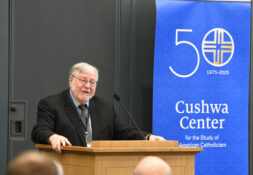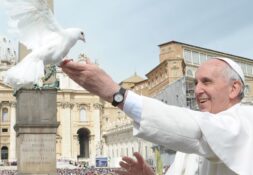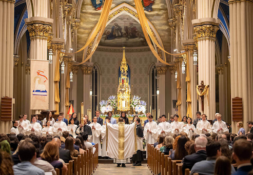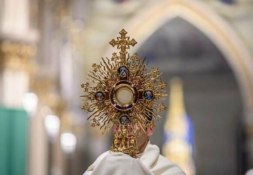Marian devotion on campus
Marian consecration, an ancient tradition in the Church whose roots stretch back to the foot of the Cross, still remains a powerful part of the Catholic practice of students and professors at the University of Notre Dame.
To “consecrate” means to set apart for sacred use. This is seen in Scripture, as sacrificial offerings and food were blessed and separated for sanctification, and as Moses sprinkled the blood of the Covenant to consecrate the Israelites themselves.
One such form of consecration is Marian in character. Famously encouraged by St. Louis de Montfort, the 18th-century French priest, in Total Consecration to Jesus Through Mary, consecration to the Blessed Virgin has seen a resurgence, particularly through 33 Days to Morning Glory by the American priest Fr. Michael Gaitley, M.I.C. Such recent saints as Pope John Paul II and Mother Teresa of Calcutta have encouraged this devotion.
Far from a modern novelty, Marian consecration is founded on a central episode in the life of Christ. When Jesus died on the Cross, He told his “beloved disciple” John, “Behold thy mother.” Entrusting His Blessed Mother and His beloved disciple to their own mutual care, Christ provided the pattern for Catholics throughout the centuries to set themselves apart both as children and custodians of their mother, the Mother of God.
In response to this episode, certain devoted saints throughout Church history formulated more specific consecration formulas with prayers to recite and reflections on which to meditate. In the eighth century, for example, Saint John of Damascus, in a homily on the Assumption, prayed, “O Lady … to you we consecrate our mind, our soul, our body, all that we are. We honor you as much as we can.”
The most famous form of this devotion, however, is Total Consecration to Jesus through Mary written by Saint Louis de Montfort. His method of consecration involves a series of passages from Scripture and other spiritual works for reflection followed by a series of litanies, prayers, and the rosary for 33 days, ending with the official Act of Consecration.
Marian consecration is well established in the Catholic Church, both East and West, with approval and encouragement from several popes, and admirable examples to follow from various saints. According to True Devotion to Mary by St. Louis de Montfort, Marian consecration disposes Catholics to greater graces from Jesus through Mary and unites them to Christ on the Cross.
Professor of Theology John C. Cavadini shared his perspective on Marian consecration in an interview with the Rover. In the past, he was inspired by students to undergo the consecration: “I felt like I needed to know more about it, and I needed to try to experience it myself.”
Marian consecration appealed to Cavadini because “some of the language in which the consecration is accepted and articulated seemed very beautiful to me.” Cavadini described it as “a language of self-giving, self-giving over to Mary, which is a way of giving yourself to Jesus.”
According to Cavadini, Marian devotion has a critical place in the Christian life. “The structure of Christian faith is going through Mary to Jesus … it’s only by contemplating Mary’s role in the Incarnation that we are contemplating as deeply as possible the self-emptying of the Word in becoming incarnate.”
He continued, “The consecration is a specification, you could say, of this basic structure of Christian faith … which really is captured in the phrase ‘Mother of God.’” Quoting John Damascene, Cavadini concluded, “The whole of the Gospel is contained in that phrase [i.e., Mother of God].”
The Militia of the Immaculata, a student organization at Notre Dame, leads a Marian consecration every semester using Fr. Gaitley’s 33 Days to Morning Glory. Fr. Brian Ching, C.S.C., the chaplain to the club and usual celebrant of their consecration Masses, explained that “Marian consecration is a way of concentrating our focus on the life of the Blessed Mother knowing that she is a shining example of a life of virtue, holiness, and devotion. Our love for and devotion to her, expressed through the act of consecration is a way of recognizing her special role in helping guide us to her Son.”
One student, freshman Joseph Muraski, explained to the Rover why he decided to do the consecration this semester: “My friend initially planted the seed, but I finally decided to begin the consecration because it was through Mary’s intercession that I was able to attend Notre Dame. And since I owe my being here to her, I feel obligated to give myself and my time here to her.”
Though Muraski has already done the consecration once, his experience doing it at Notre Dame is distinct. “Doing this as I adjust to college life has been a great help to remind me what I should be focusing on, which is prayer and giving myself in order to serve God. It has also helped me to be grateful for so many things throughout everyday life as well as the great things God has done for me.”
Kathryn Bowers is a junior from Dallas, Texas who enjoys listening to music in Italian. Email her with other music recommendations at kbowers2@nd.edu.
Christopher de la Viesca is a junior in Fischer Grad and studies mathematics and theology. He also plays the piano and has a passion for the Traditional Latin Mass. Contact him at cdelavie@nd.edu.
Photo Credit: Angelos Akotantos, Creative Commons
Subscribe to the Irish Rover here.
Donate to the Irish Rover here.





